Page 3 of 350
TABLE OF CONTENTSSECTIONPAGE
1
INTRODUCTION .............................................................3
2
THINGS TO KNOW BEFORE STARTING YOUR VEHICLE .............................9
3
UNDERSTANDING THE FEATURES OF YOUR VEHICLE .............................95
4
UNDERSTANDING YOUR INSTRUMENT PANEL ..................................147
5
STARTING AND OPERATING .................................................205
6
WHAT TO DO IN EMERGENCIES ..............................................263
7
MAINTAINING YOUR VEHICLE ...............................................283
8
MAINTENANCE SCHEDULES .................................................321
9
IF YOU NEED CONSUMER ASSISTANCE ........................................327
10
INDEX ....................................................................337
1
2
3
4
5
6
7
8
9
10
Page 231 of 350

NOTE:
•The ESC Activation/Malfunction Indicator Light and
the ESC OFF Indicator Light come on momentarily
each time the ignition switch is turned ON.
• Each time the ignition is turned ON, the ESC system
will be ON even if it was turned off previously.
The ESC OFF Indicator Light indicates the
Electronic Stability Control (ESC) is off.
Regenerative Braking
Your 500e has a Regenerative Braking System (RBS). The
RBS increases the fuel economy of the vehicle, particu-
larly in stop-and-go city traffic. The electric motors which propel the vehicle forward can operate as generators
when braking. The RBS recharges the high voltage bat-
tery under certain braking conditions by recapturing
energy that would otherwise be lost while braking. The
electric power that is generated goes back into the high
voltage battery for later use, for example when accelera-
tion is desired.
The RBS uses conventional hydraulic friction brakes,
regenerative braking, or a combination to slow the ve-
hicle. If the system detects slippery conditions while
braking, mainly friction is used to slow the vehicle. The
RBS can result in extended life of the hydraulic service
brakes; however, all inspection, scheduled maintenance,
and service intervals for the vehicle service brakes must
be followed.
5
STARTING AND OPERATING 229
Page 252 of 350
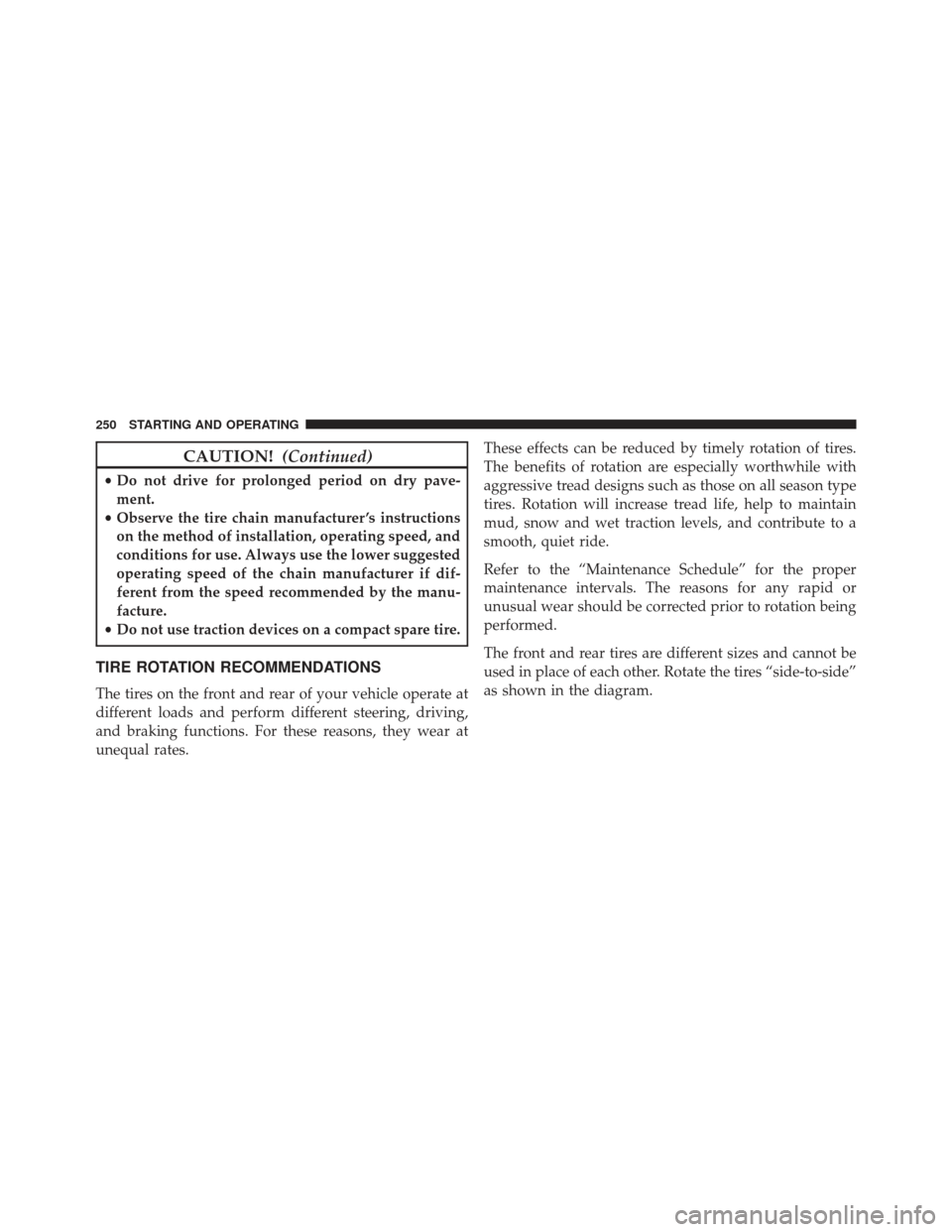
CAUTION!(Continued)
•Do not drive for prolonged period on dry pave-
ment.
• Observe the tire chain manufacturer ’s instructions
on the method of installation, operating speed, and
conditions for use. Always use the lower suggested
operating speed of the chain manufacturer if dif-
ferent from the speed recommended by the manu-
facture.
• Do not use traction devices on a compact spare tire.
TIRE ROTATION RECOMMENDATIONS
The tires on the front and rear of your vehicle operate at
different loads and perform different steering, driving,
and braking functions. For these reasons, they wear at
unequal rates. These effects can be reduced by timely rotation of tires.
The benefits of rotation are especially worthwhile with
aggressive tread designs such as those on all season type
tires. Rotation will increase tread life, help to maintain
mud, snow and wet traction levels, and contribute to a
smooth, quiet ride.
Refer to the “Maintenance Schedule” for the proper
maintenance intervals. The reasons for any rapid or
unusual wear should be corrected prior to rotation being
performed.
The front and rear tires are different sizes and cannot be
used in place of each other. Rotate the tires “side-to-side”
as shown in the diagram.
250 STARTING AND OPERATING
Page 262 of 350
•perform all scheduled maintenance at recommended
intervals
Driver Behavior Gauge
To help the driver extend the driving range of the high
voltage battery your vehicle is equipped with a Driver
Behavior Gauge. The Driver Behavior Gauge is located
on the right side of the instrument cluster and contains
three driving ranges:
• Power
The needle will move into the Power range when under
acceleration.
• ECO
The needle will move into the ECO range when you are
maximizing the driving range of the high voltage battery. •
Charge
The needle will move into the Charge range when battery
regeneration is active (either coasting or braking).
Driver Behavior Gauge
260 STARTING AND OPERATING
Page 288 of 350
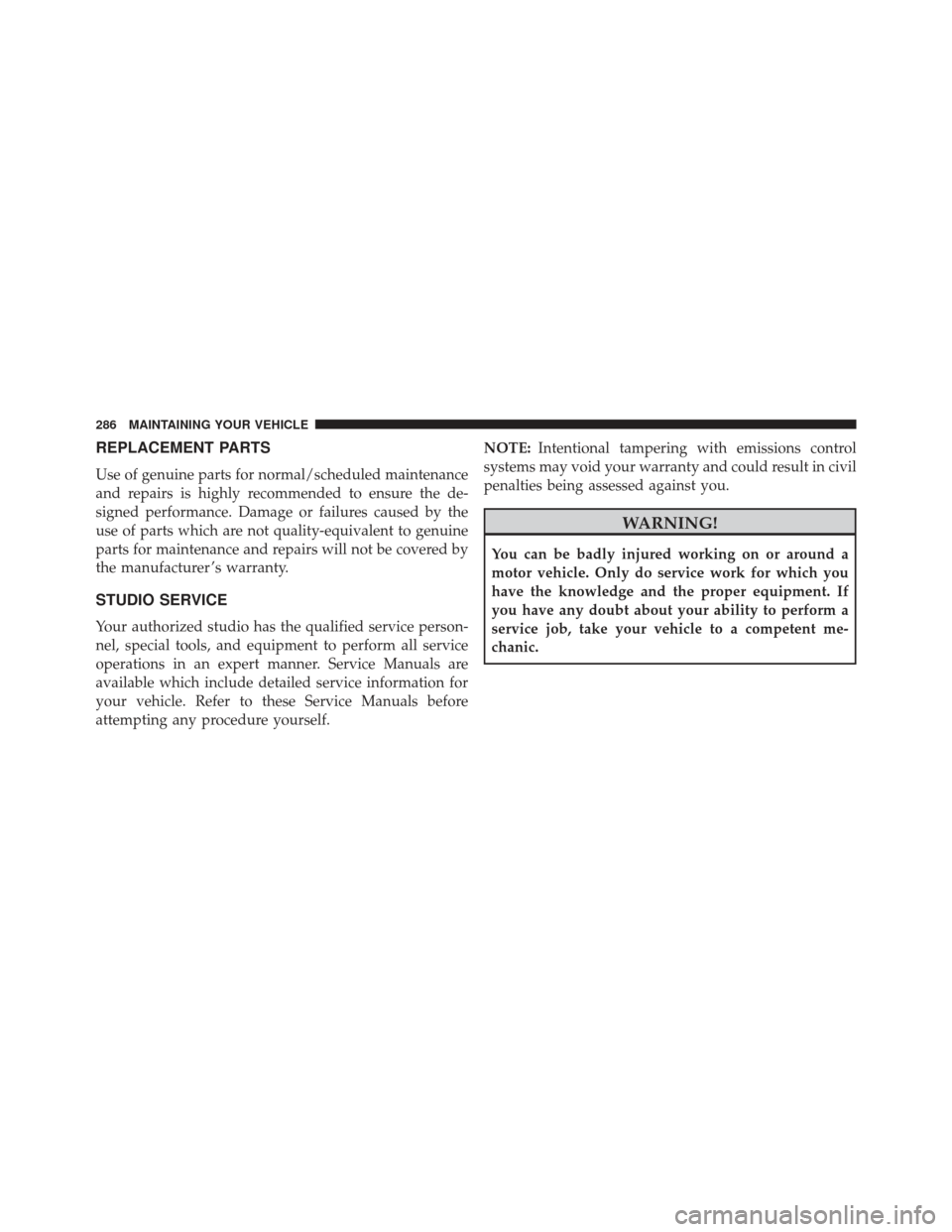
REPLACEMENT PARTS
Use of genuine parts for normal/scheduled maintenance
and repairs is highly recommended to ensure the de-
signed performance. Damage or failures caused by the
use of parts which are not quality-equivalent to genuine
parts for maintenance and repairs will not be covered by
the manufacturer ’s warranty.
STUDIO SERVICE
Your authorized studio has the qualified service person-
nel, special tools, and equipment to perform all service
operations in an expert manner. Service Manuals are
available which include detailed service information for
your vehicle. Refer to these Service Manuals before
attempting any procedure yourself.NOTE:
Intentional tampering with emissions control
systems may void your warranty and could result in civil
penalties being assessed against you.
WARNING!
You can be badly injured working on or around a
motor vehicle. Only do service work for which you
have the knowledge and the proper equipment. If
you have any doubt about your ability to perform a
service job, take your vehicle to a competent me-
chanic.
286 MAINTAINING YOUR VEHICLE
Page 289 of 350
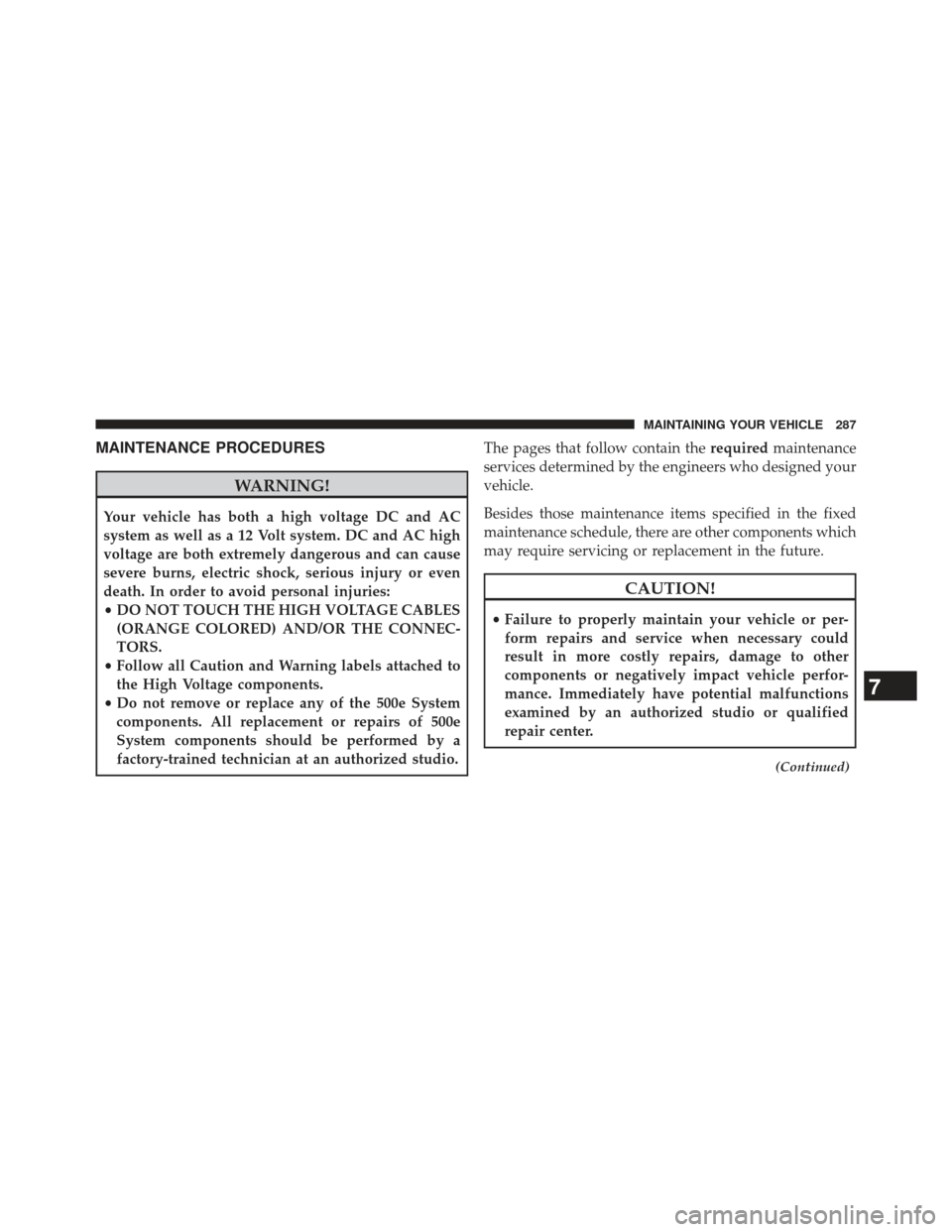
MAINTENANCE PROCEDURES
WARNING!
Your vehicle has both a high voltage DC and AC
system as well as a 12 Volt system. DC and AC high
voltage are both extremely dangerous and can cause
severe burns, electric shock, serious injury or even
death. In order to avoid personal injuries:
•DO NOT TOUCH THE HIGH VOLTAGE CABLES
(ORANGE COLORED) AND/OR THE CONNEC-
TORS.
• Follow all Caution and Warning labels attached to
the High Voltage components.
• Do not remove or replace any of the 500e System
components. All replacement or repairs of 500e
System components should be performed by a
factory-trained technician at an authorized studio. The pages that follow contain the
requiredmaintenance
services determined by the engineers who designed your
vehicle.
Besides those maintenance items specified in the fixed
maintenance schedule, there are other components which
may require servicing or replacement in the future.
CAUTION!
• Failure to properly maintain your vehicle or per-
form repairs and service when necessary could
result in more costly repairs, damage to other
components or negatively impact vehicle perfor-
mance. Immediately have potential malfunctions
examined by an authorized studio or qualified
repair center.
(Continued)
7
MAINTAINING YOUR VEHICLE 287
Page 295 of 350
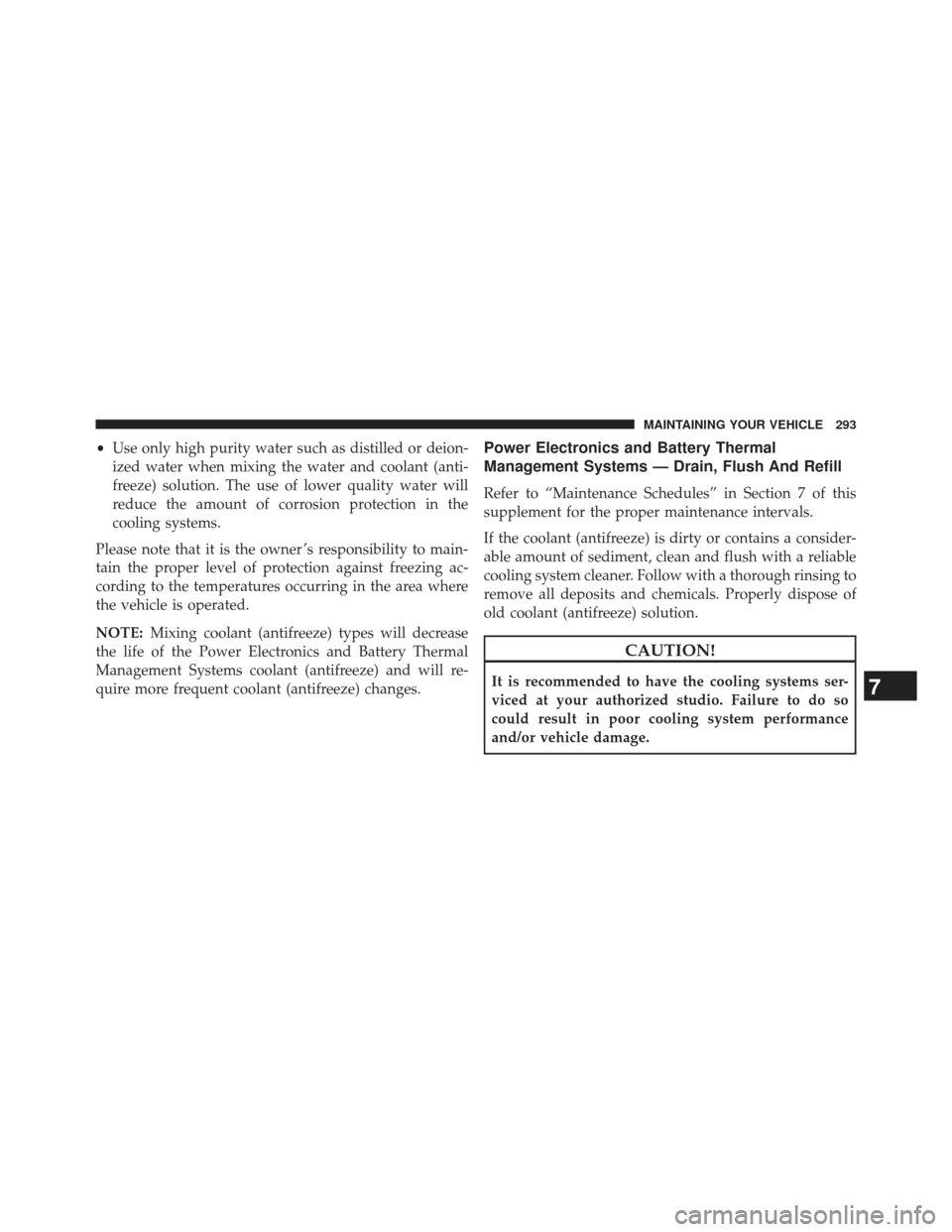
•Use only high purity water such as distilled or deion-
ized water when mixing the water and coolant (anti-
freeze) solution. The use of lower quality water will
reduce the amount of corrosion protection in the
cooling systems.
Please note that it is the owner ’s responsibility to main-
tain the proper level of protection against freezing ac-
cording to the temperatures occurring in the area where
the vehicle is operated.
NOTE: Mixing coolant (antifreeze) types will decrease
the life of the Power Electronics and Battery Thermal
Management Systems coolant (antifreeze) and will re-
quire more frequent coolant (antifreeze) changes.Power Electronics and Battery Thermal
Management Systems — Drain, Flush And Refill
Refer to “Maintenance Schedules” in Section 7 of this
supplement for the proper maintenance intervals.
If the coolant (antifreeze) is dirty or contains a consider-
able amount of sediment, clean and flush with a reliable
cooling system cleaner. Follow with a thorough rinsing to
remove all deposits and chemicals. Properly dispose of
old coolant (antifreeze) solution.
CAUTION!
It is recommended to have the cooling systems ser-
viced at your authorized studio. Failure to do so
could result in poor cooling system performance
and/or vehicle damage.7
MAINTAINING YOUR VEHICLE 293
Page 301 of 350
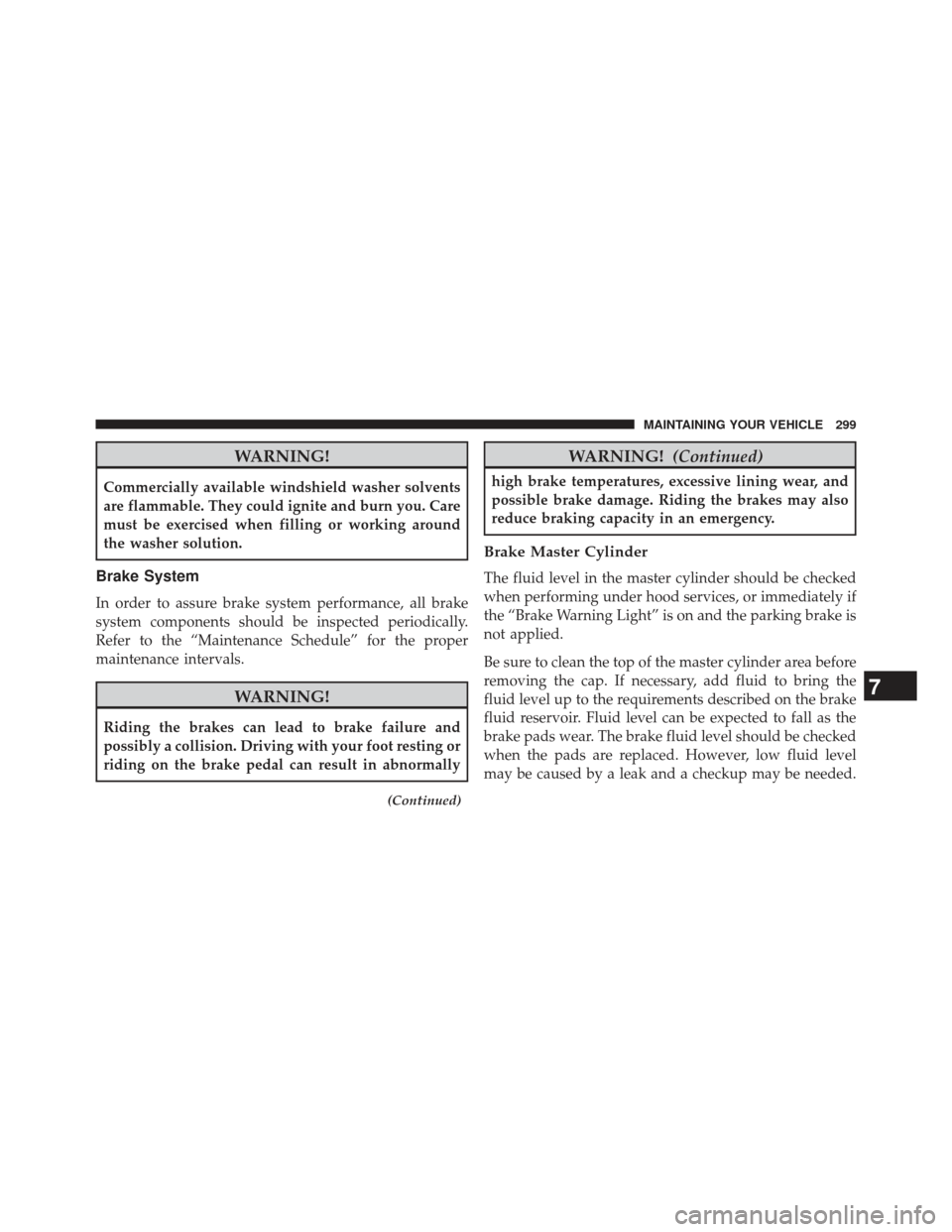
WARNING!
Commercially available windshield washer solvents
are flammable. They could ignite and burn you. Care
must be exercised when filling or working around
the washer solution.
Brake System
In order to assure brake system performance, all brake
system components should be inspected periodically.
Refer to the “Maintenance Schedule” for the proper
maintenance intervals.
WARNING!
Riding the brakes can lead to brake failure and
possibly a collision. Driving with your foot resting or
riding on the brake pedal can result in abnormally
(Continued)
WARNING!(Continued)
high brake temperatures, excessive lining wear, and
possible brake damage. Riding the brakes may also
reduce braking capacity in an emergency.
Brake Master Cylinder
The fluid level in the master cylinder should be checked
when performing under hood services, or immediately if
the “Brake Warning Light” is on and the parking brake is
not applied.
Be sure to clean the top of the master cylinder area before
removing the cap. If necessary, add fluid to bring the
fluid level up to the requirements described on the brake
fluid reservoir. Fluid level can be expected to fall as the
brake pads wear. The brake fluid level should be checked
when the pads are replaced. However, low fluid level
may be caused by a leak and a checkup may be needed.
7
MAINTAINING YOUR VEHICLE 299